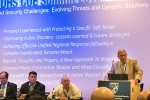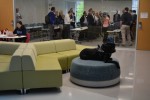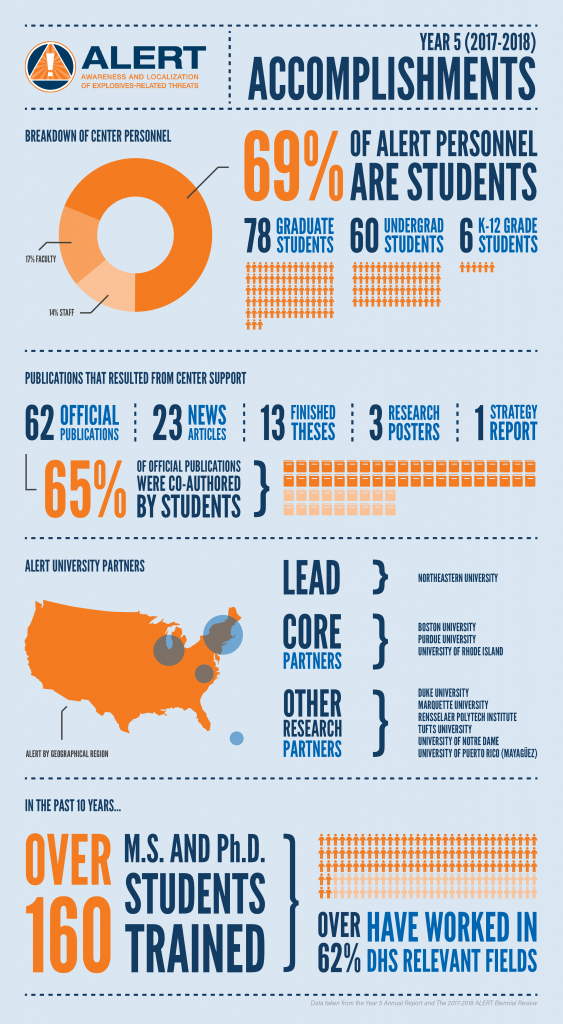News & Events
ALERT Newsletter
ALERT Phase 2 Year 6 Annual Report Available Online! August 30, 2019

August 30, 2019
ALERT is proud to announce that the Phase 2 Year 6 Annual Report is now available online. The report details the continued research in ALERT’s four research thrusts:
- R1: Characterization & Elimination of Illicit Explosives
- R2: Trace & Vapor Sensors
- R3: Bulk Sensors & Sensor Systems
- R4: Video Analytics & Signature Analysis
The report also contains a full bibliography of the journal articles and conference proceedings published under ALERT support in the past year (July 1, 2018 to June 30, 2019), as well as comprehensive descriptions of the Year 6 activities that took place in the following areas:
- ALERT Phase 2 Overview and Year 6 Highlights
- Research and Transition Plan
- Education Program
- Transition and E2E Projects
- Strategic Studies Program
- Safety Program
- Information Protection Program
- Industrial Liaison Initiatives and Partnerships
- Infrastructure and Evaluation
For reports from previous years, please visit: https://alert.northeastern.edu/annual-reports/
ALERT Graduate Student, David Benirschke Receives Postdoctoral Fellowship August 30, 2019

August 30, 2019
This summer, ALERT Graduate Student, David Benirschke accepted the prized Intelligence Community (IC) Postdoctoral Research Fellowship. The Oak Ridge Institute for Science and Education oversees this fellowship, funded primarily by the Office of the Director of National Intelligence, to support Postdoctoral Fellows to conduct unclassified basic research in areas of interest to the IC, such as David’s research in infrared-based explosive detection conducted while pursuing his PhD in Electrical Engineering at Notre Dame.
David has been a key contributor on the ALERT Project R2-C.2: Multiplexed Mid-Infrared Imaging of Trace Explosives, led by ALERT Researcher Dr. Scott Howard, an Associate Professor at Notre Dame. Through his participation, David worked with the project team to build upon prior ALERT research to create lower cost MIR technology for field use. With the aspiration of identifying explosive residue on objects in mind, David engineered many experimental prototypes, utilizing his deep theoretical knowledge in the area, eventually creating a spotlight in the mid-infrared (MIR), as well.
David will defend his PhD dissertation on “Realization of a low-cost, spectroscopic, mid-Infrared platform for enabling sensing applications and laser induced time-harmonic thermal imaging,” in September and will begin his fellowship collaborating with Notre Dame Assistant Professor, and IC Research Advisor, Dr. David Burghoff in October.
Regarding David’s intentions for this exciting fellowship, he states,
“The goal of my post-doctoral project is to realize a remote sensing system utilizing a newer type of laser source called a ‘Frequency comb’. These sources have already been used for highly controlled laboratory experiments. My goal is to try and take them out into the ‘real’ world. Realizing this system will directly enable many sensing applications including that of my work in R2-C.2 on explosives detection.”
The ultramodern technology soon to be researched by David and Dr. Burghoff, will aid the advancement towards cost effective, field applicable, and more precise sensing as a dynamic response to explosives-related threats.
Second Annual DHS COE Summit Highlights Homeland Security Challenges August 30, 2019

The 2019 Department of Homeland Security (DHS) Centers of Excellence (COE) Summit was held on Wednesday, July 31st and Thursday, August 1st at George Mason University in Arlington, Virginia. This year’s summit focused on the topic of Homeland Security Challenges: Evolving Threats and Dynamic Solutions.
The ALERT management team collaborated with other COE leadership to coordinate the second year of this unique event. The 2019 Summit involved stimulating panel discussions on homeland security topics, intriguing demonstrations of COE technologies, and focused engagement opportunities for students, industry and DHS end-users. This year’s attendees included a broad range of participants including COE researchers and collaborators, members of industry, and several divisions of the US Government. During the summit, interaction amongst these attendees helped create new connections, inspire ideas, and advance collaboration towards solving homeland security issues.
The agenda for the summit began with a keynote address from Matt Coates, Deputy Director for the DHS Office of University Programs, which led into the two-day agenda including concurrent panel discussions focused on two topics – Gray Zone Threats and Homeland Security Challenges in a Highly Networked World. ALERT Director, Michael B. Silevitch led a panel discussion on how these Gray Zone Threats extend to physical soft targets and crowed places outside of the traditional military, industrial or political infrastructure. The focus of the panel addressed active shooter events and panel members included Larry Balding from ALERRT, Matthew Pruitt of NEC, Kevin Clement from the University of Houston College of Technology, Carl Crawford of Csuptwo, and Neil Sandhoff from Evolv Technology.
Another highlight of the summit was the Innovation Showcase, which allowed COEs to provide live or video demonstrations of their successful research efforts. This showcase established an environment for discussion of technology transfer opportunities between the COEs and attendees from the DHS components and industry. ALERT highlighted its recent successes with stand-off detection technologies, 3D cargo scanning, millimeter wave imaging, and video analytics in an airport security checkpoint.
Outside the Innovation Showcase area, ALERT students Mohammad Nemati of Northeastern University and Annette Colón Mercado of the University of Puerto Rico at Mayaguez (UPRM) were on-hand to represent ALERT’s research in Thrust R3 related to bulk sensors and sensor systems as part of the summit’s COE Student Poster Display and Competition.
DHS COEs take pride in their students’ contributions and efforts. To foster student innovation, student participants were encouraged to take part in the summit’s “Grand Challenge” competition. Leading up to and culminating at the summit, talented undergraduate and graduate students from each of the COEs collaborated on solutions to address emerging homeland security concerns. ALERT students, Emily Belk of Northeastern University and Annette Colón Mercado of UPRM both participated in this challenge and both were recognized for their efforts.
The summit concluded with a DHS keynote address from William N. Bryan, Senior Official Performing the Duties of the Under Secretary for S&T, who also presented certificates to the winners of the Grand Challenge Award. First place winners proposed an “Automated Drone Integrated Information System (ADIIS)” and included ALERT Student Emily Belk of Northeastern University. Emily presented the team’s proposal to the summit audience. The ADIIS goal is to address the challenge in identifying and classifying UAS through a combination of registration incentives and tracking methods. The team including ALERT Student Annette Colón Mercado of the University of Puerto Rico at Mayaguez (UPRM), won second place for their proposal entitled, “Drone-based MIR Laser Induced Thermal Imaging for Identification of Chemical Substances.” The group explained their proposal’s value as it would reduce the amount of human resources needed during security missions, increase situational awareness, and minimize illicit chemicals crossing the border.
The summit provided an extremely collaborative environment to address homeland security issues by gathering some of the top academic, public, and private sector leaders in the world to discuss strategy and the advancement towards Homeland Security goals. ALERT looks forward to the next DHS COE Summit and congratulations to both Grand Challenge teams, Emily, and Annette!
ALERT Hosts Technology Showcase & ADSA20 Workshop May 29, 2019

May 29, 2019
Earlier this month, the ALERT Center of Excellence hosted the ALERT Technology Showcase (May 14th) in conjunction with the ADSA20 Workshop (May 15th & 16th) at Northeastern University. The ALERT Technology Showcase featured presentations, posters, and technology demonstrations of the Center’s research and tools and highlighted the Center’s collaborative work with industry and government stakeholders, such as Astrophysics, Inc., DetectaChem, ENrG Inc., Pendar Technologies, Lawrence Livermore National Laboratory, Quadridox, Rapiscan Systems, Signature Sciences, and Smiths Detection, to name a few. The objective of the event was to demonstrate the transition of ALERT’s work to Department of Homeland Security components, such as the Transportation Security Administration and U.S. Customs and Border Protection, as well as its impact on the homeland security enterprise as a whole.
The twentieth workshop for Advanced Development for Security Applications (ADSA20) addressed the theme of “design, development, testing, deployment, and operation of effective systems.” Specific topics that were discussed during the workshop included: defining effective, effectiveness for stakeholders (airlines, passengers) and venues (subway, rail, cargo), humans in the loop, applications of metadata, rapid response to an adapting adversary, the role of artificial intelligence, and the transition of technology from academia to industry.
More than 160 attendees from academia, industry, and government participated in the ALERT Technology Showcase and ADSA20 Workshop, resulting in two of the most engaging events ALERT has hosted yet.
Regarding the value of the ALERT Technology Showcase, Francois Zayek, CEO of Astrophysics, Inc. stated
“I’m pleased to be here. I’m happy to see all the presentations, because again, we are so much involved in our industry. We are so much involved in the business, that we keep ourselves a little bit further away from the technologies, so every now and then it would be very helpful—and healthy—to come in and then see what is happening in the technology arena.”
Professor David Castañón (Boston University) and the lead for ALERT’s research on Video Analytics and Signature Analysis (Thrust R4), shared his thoughts on the most valuable aspect of the event stating
“It’s getting the feedback from a potential user. That is somebody who says ‘I have a problem this would be useful for.’ I’ve had two or three of those interactions while I have been here with the posters and it has been very nice.”
The next event ALERT will be hosting is the second workshop on Advanced Developments Encompassing Processes and Technologies for Customs and Border Protection (CBP-ADEPT-02), which will be held July 17th and 18th at Northeastern University. For more information on upcoming events and workshops, visit the ALERT website: www.northeastern.edu/alert
Photo: K9 Figaro waits patiently to participate in a demo of TEAS (Trace Explosives Aids for Scent), which ALERT developed in collaboration with DetectaChem, and showcased at the recent ALERT Technology Showcase as an example of safer training aids for explosives detection canines and first responders.
ALERT Researchers Awarded Patent May 29, 2019

May 29, 2019
ALERT researchers, Professor Carey Rappaport and Professor Jose Martinez-Lorenzo of Northeastern University were awarded a patent for an “On-the-Move Millimeter Wave Interrogation System with a Hallway of Multiple Transmitters and Receivers” on May 21, 2019.
In conventional screening systems that use radar imaging for surveillance and detection purposes, an object of interest may be illuminated (using millimeter wave) and the scattered field measured and processed to reconstruct a feature of the object. These systems may generate an image that profiles a detectable shape, outline and/or movement of an object or subject; however, conventional radar systems, such as a portal-based system, constrains a subject from movement. Professor Rappaport and Professor Martinez-Lorenzo’s patented solution allows for screening an unconstrained subject, meaning an individual could be scanned for foreign objects attached to their bodies (such as explosives and weapons hidden under clothing) as they moved through a hallway of transmitters and receivers. Such a system could lead to faster and more accurate screening of individuals as they make their way through security checkpoints.
Read more about the “On-the-Move Millimeter Wave Interrogation System with a Hallway of Multiple Transmitters and Receivers” patent here.
To learn more about the work Professor Rappaport and Professor Martinez-Lorenzo are doing to make screening for explosives and weapons more effective and efficient, visit their respective project pages: Projects R3-A.2 and R3-A.3, and Project R3-B.1.
ALERT’s Newest Industrial Members: 908 Devices and Rigaku Analytical Devices May 29, 2019

May 29, 2019
This spring, the ALERT Center of Excellence welcomed 908 Devices and Rigaku Analytical Devices as the Center’s newest industrial members thanks to their generous donations of equipment to further ALERT research efforts at the University of Rhode Island (URI).
908 Devices is a fast-growing business in Boston, Massachusetts that develops products ranging from rugged, handheld chemical detection tools to compact, tiny footprint analyzers and fast separation devices. These purpose-built and user-centric devices serve a range of industries including field forensics, oil and gas, life sciences, and other applied markets.
908 Devices donated twenty M908TM portable mass spectrometers to the Chemistry Department at URI to support the high school education programming run by Dr. Jimmie Oxley (ALERT Research Thrust 1 Lead) and Dr. James Smith (ALERT Education Program Co-Lead).The M908TM is the company’s first product based on their patented and proven high-pressure mass spectrometryTM. M908TM is currently being used by CBRNE and HAZMAT organizations around the world for chemical detection, with at least one M908TM device deployed in every state across the United States.
Rigaku Analytical Devices is a leading pioneer and innovator of handheld and portable spectroscopic analyzers for use in the protection of public health and safety, aid in the advancement of scientific and academic study, enable the recycle and reuse of metal alloys, and ensure quality of key metal alloy components in mission-critical industries. Their advanced and rugged products deliver unparalleled accuracy and extensive application support, empowering their customers to achieve rapid lab-like results any time, any place.
Rigaku Analytical Devices donated a KT-100STM alloy analyzer (handheld laser induced breakdown spectroscopy technology) to Dr. Oxley’s lab at URI.
ALERT industrial membership has several advantages. Through various events, ALERT provides members the opportunity to network with other industrial members, faculty from ALERT’s partner institutions, and representatives from local, state, and federal governments. Other advantages of ALERT industrial membership include admission to two exclusive members-only events: The Annual Student Pipeline Industry Roundtable Event (ASPIRE), which provides industrial members with access to qualified job-seeking students; and the ALERT Industrial Advisory Board meeting, which features engaging guest speakers, highlights of successful government-industry-academia collaboration, and networking opportunities. Members also have the opportunity to request targeted research in an area of interest to their organizations. As an added bonus, registration fees are waived for industrial members attending ALERT’s public workshops, such as the ADSA Workshop and CBP-ADEPT Workshop series.
For more information on the advantages of ALERT industrial membership, please see the Benefits of Collaboration, or contact our Industrial and Government Liaison Officer, Ms. Emel Bulat at [email protected], or our Industry Liaison Associate, Ms. Kristy Provinzano at [email protected].
Rigaku Analytical Devices: ALERT’s Newest Industrial Member May 7, 2019
May 9, 2019
ALERT is pleased to welcome Rigaku Analytical Devices as its newest industrial member thanks to their donation of a KT-100S alloy analyzer (handheld LIBS technology) to Dr. Jimmie Oxley (ALERT Research Thrust 1 Lead) at the University of Rhode Island.
Rigaku Analytical Devices is a leading pioneer and innovator of handheld and portable spectroscopic analyzers for use in the protection of public health and safety, aid in the advancement of scientific and academic study, enable the recycle and reuse of metal alloys, and ensure quality of key metal alloy components in mission-critical industries. Their advanced and rugged products deliver unparalleled accuracy and extensive application support, empowering their customers to achieve rapid lab-like results any time, any place.
ALERT industrial membership has several advantages. Through various events, ALERT provides members the opportunity to network with other industrial members, faculty from ALERT’s partner institutions, and representative from local, state, and federal governments. Other advantages of ALERT industrial membership include admission to two exclusive members-only events: The Annual Student Pipeline Industry Roundtable Event (ASPIRE), which provides industrial members with access to qualified job-seeking students; and the ALERT Industrial Advisory Board meeting, which features engaging guest speakers, highlights of successful government-industry-academia collaboration, and networking opportunities. Members also have the opportunity to request targeted research in an area of interest to their organizations. As an added bonus, registration fees are waived for industrial members attending ALERT’s public workshops, such as the ADSA Workshop and CBP-ADEPT Workshop series.
For more advantages of ALERT industrial membership, please see the Benefits of Collaboration, or contact our Industrial and Government Liaison Officer, Ms. Emel Bulat at [email protected], or Ms. Kristy Provinzano at [email protected].
Making Connections at ASPIRE 2019 March 27, 2019

March 28, 2019
This week, STEM students from ALERT’s academic partner institutions, and representatives from ALERT’s Industrial Members and government collaborators gathered together at Northeastern University for the Annual Student Pipeline Industry Roundtable Event (ASPIRE 2019). The aim of the ASPIRE series is to connect members of the industrial and government communities with qualified STEM students looking for internships, co-ops, and full-time jobs related to homeland security.
ASPIRE 2019 kicked off with welcoming remarks from Michael Silevitch (Director, ALERT), Emel Bulat (Senior Consultant for Corporate & Government Partnerships, ALERT), and Kristy Provinzano (Industry Liaison Associate, ALERT). Following this, ALERT Industry Members (American Science & Engineering, Rapiscan Systems, Raytheon, Smiths Detection) and representatives from the Department of Homeland Security and the U.S. Customs & Border Protection introduced student career opportunities at their respective organizations.
According to Adam Hutter, Laboratory Director at U.S. Customs and Border Protection’s New York Laboratory, “We’re constantly hiring, so we want to make sure we’re bringing in the best talent we can. The Department of Homeland Security has already invested heavily in these students through the Centers of Excellence pipeline, so it’s a resource we should utilize. These students have a leg up, because they’re already working on homeland security problems.”
ASPIRE 2019 featured both group and one-on-one meetings between students and representatives from industry and government. Many of the participants, like Jose Ruiz-Caballero who works on ALERT Project R3-C at the University of Puerto Rico Mayaguez, were ASPIRE returnees interested in jobs: “It’s a high impact event from my professional point of view, because you have direct contact with industry and government and they can provide you with a profile of what they’re looking for in a candidate.”
Molly Baldwin, a Purdue University undergraduate who works on ALERT Project R2-A.3 and is about to graduate is looking toward the future: “I started working on the research project last semester and fell in love with this industry. I’m here to see what jobs are out there for chemical engineers. I could see myself continuing to do research to improve the detection of explosives.”
For other students, the event is a great networking opportunity and a chance to gain experience speaking with job recruiters. First year student and first time ASPIRE attendee, Ian Hay, who does breast cancer detection research at Northeastern University, isn’t looking for a job quite yet, but found the event to be beneficial. According to Hay, “Communicating with different companies, both public and private, is valuable to me, especially in a low-pressure setting. Being able to meet with representatives and explain my work and how it applies to their industry is great practice.”
Since its establishment as a DHS Center of Excellence, ALERT has prioritized training the next generation of professionals to tackle explosives-related threats. Over the past 12 years, ALERT has trained over 160 graduate students, resulting in more than 100 of these professionals working in DHS-relevant fields. Events like ASPIRE 2019 are a significant part of ALERT’s mission to provide educational development to improve effective characterization, detection, mitigation and response to explosives-related threats facing the nation and the world.
Infographic: ALERT’s Year 5 (2017-2018) Accomplishments January 29, 2019
January 29, 2019
As we begin the New Year, we are also looking back on the previous year! Check out our newest infographic on ALERT’s Year 5 (2017-2018) Accomplishments.
ALERT Researchers Selected as IEEE Fellows January 29, 2019

January 29, 2019
Please join us in congratulating the newly elevated IEEE Fellows for the Class of 2019! We are especially proud of ALERT researchers Mario Sznaier of Northeastern University, and David Castañón and Venkatesh Saligrama of Boston University for this significant achievement. IEEE Fellow is a distinction reserved for select IEEE members whose extraordinary accomplishments in any of the IEEE fields of interest are deemed fitting of this prestigious grade elevation. The total number selected in any one year does not exceed one-tenth of one percent of the total voting IEEE membership.
Mario Sznaier is a Northeastern University ECE Professor and co-leads ALERT Project R4-A.1. Sznaier has been elevated to an IEEE Fellow for his contributions to identification of switched systems and multiobjective control. His work on Project R4-A.1 aims to substantially enhance our ability to exploit surveillance camera networks to predict and isolate threats from explosive devices in heavily crowded public spaces, and to guide complementary detection modalities, subsequent to a threat alert.
David Castañón and Venkatesh Saligrama are Boston University ECE Professors and collaborators on ALERT Project R4-A.2. Castañón has been elevated to an IEEE Fellow for his contributions to discrete-time stochastic control and information fusion. Saligrama has been elevated to an IEEE Fellow for his contributions to distributed detection and estimation of structured signals. Their work on Project R4-A.2 aims to leverage machine learning and computer vision methods for surveillance over multi-camera networks and to develop methods that are capable of real-time and forensic detection of suspicious activity.


